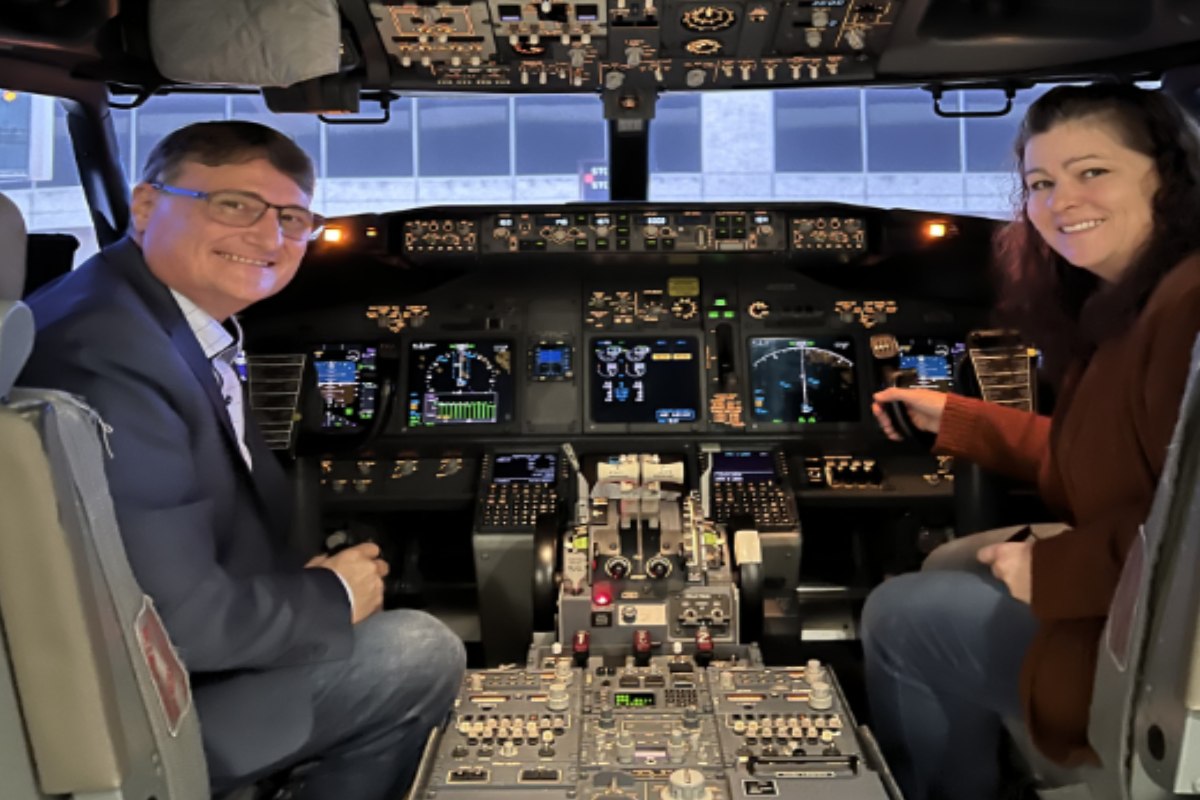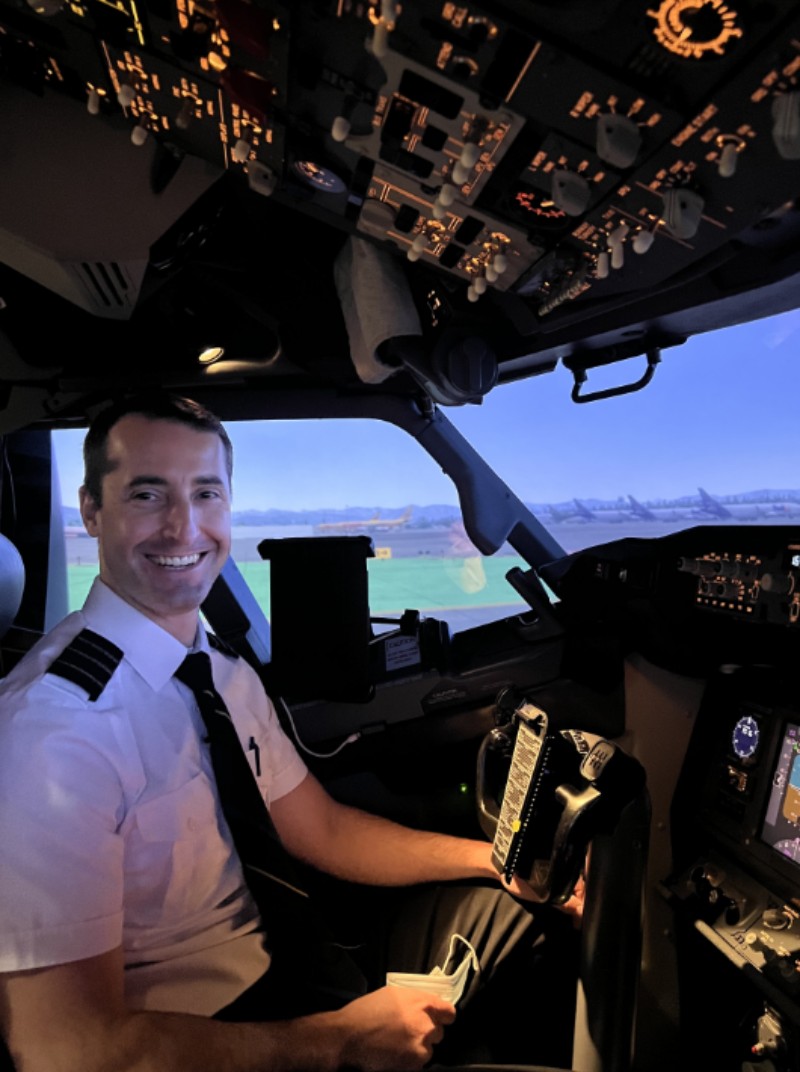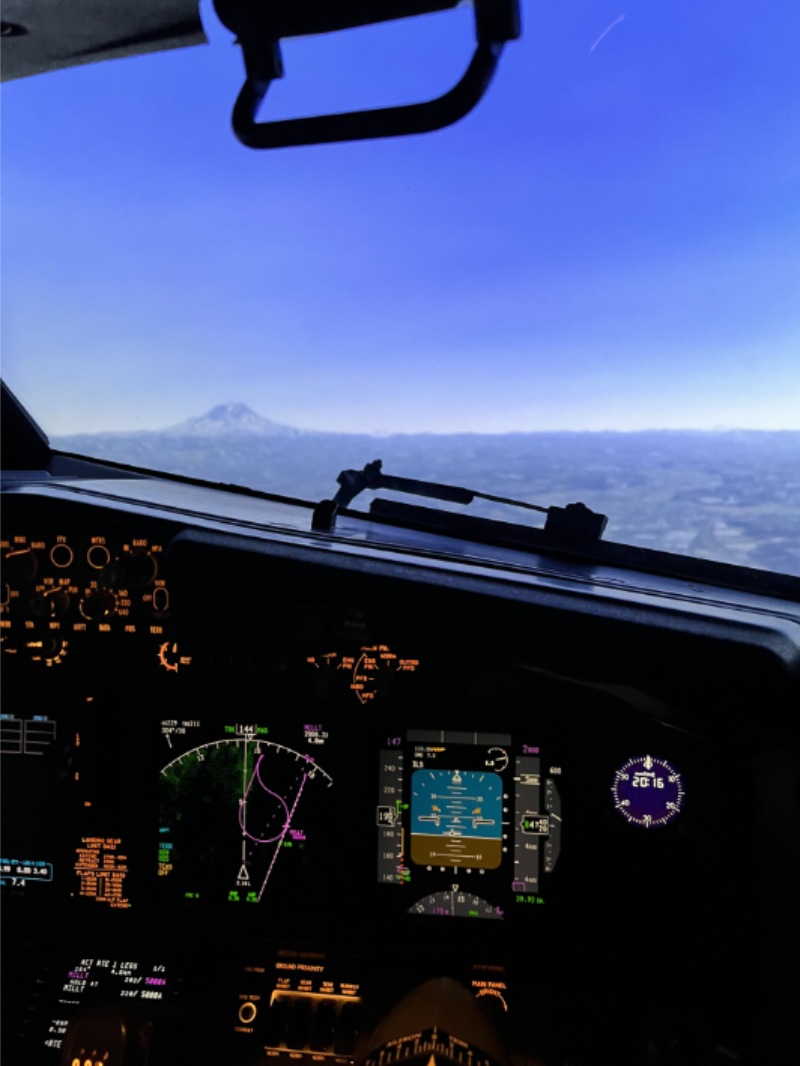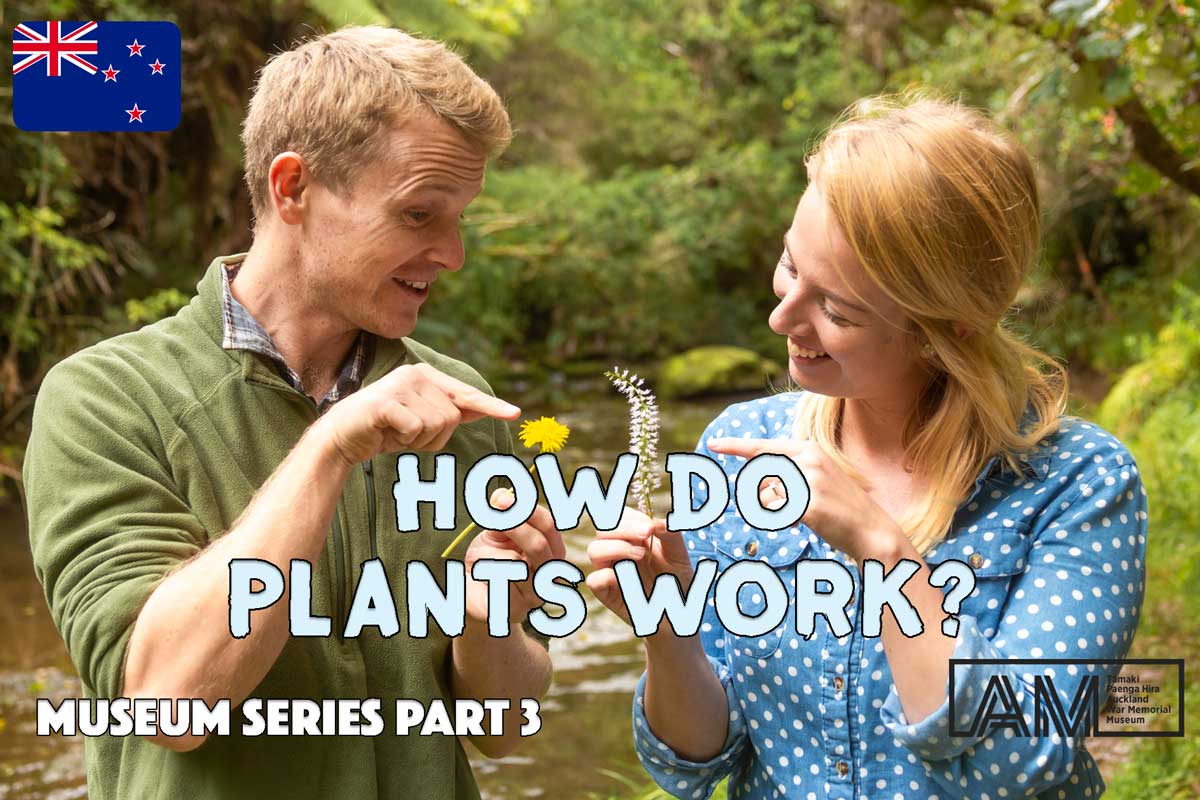Fifth Graders on Alaska Flight 411

9 a.m. Jan. 28, 2022– Alaska flight 411 departs Seatac Airport, heading for Fairbanks, Alaska. The plane levels off at 30,000 feet. The pilots ask the flight attendant, Scott, for two coffees with vanilla flavoring.
Scott pours the coffee and reaches for the vanilla flavoring. It’s empty. Scott substitutes almond milk for flavoring and delivers two piping hot cups of coffee to the pilots.
Captain Robert Senior and Co-Pilot Robert Junior are father and son. This is Junior’s first flight with passengers. Senior joined his son for his maiden voyage with Alaska Airlines. Senior and Junior share a lot in common. Unfortunately they also share the same allergy to almond milk.
Scott and his co-worker started to serve drinks to passengers. They made it about halfway down the aisle when the plane yawed violently to the left. Their cart slammed into an unoccupied seat. Cans exploded. Passengers screamed.
The intercom crackled, “Alert 4, Alert 4…” and then went silent. Scott’s mouth went dry. Adrenaline coursed through his veins, “No, I must have heard that wrong.” Alert 4 is an emergency code known only by the crew.
Scott raced to the cockpit to find both pilots gasping for air. “I’ve seen these symptoms before, anaphylactic shock! Must be the almond milk,” Scott muttered.
The plane banked in a large circle slowly losing altitude. Scott picked up the mic to the cabin intercom, “Ladies and gentlemen, if any of you have medical training and know how to fly a 737, please come to the cockpit immediately.”
Scott tried to sound calm so as to not panic the passengers. He failed. High pitched screams echoed throughout the fuselage.
Stacey, sitting in row 2, seat B, beside her husband, Andrew, put down her crocheting and turned to him, “Oh dear lord, please don’t spring into action, Andrew. Certainly qualified passengers are on board to deal with this.”
Ignoring his wife, Andrew bolted up and bellowed, “Silence!” A hush went through the cabin. All eyes turned to him. “Who is trained in first aid?” Two hands went up. “You, go to the cockpit and assist.” The medics ran to the cockpit. “Who knows how to fly an airplane?” No hands raised, only blank stares.
A couple of months earlier a 5th grade teacher named Andrew Fritz took his class to Alaska Airlines Flight Operations Center at Seatac International Airport to learn about the physics of flight. After the lesson, Captain Joseph Vacca offered Mr. Fritz a chance to experience commanding a $15,000,000 million dollar flight simulator based on the 737-900 ER aircraft. Captain Joe walked him through the steps of takeoff and landing. Mr. Fritz did not disappoint the class, he flew the plane fairly well for a newbie and managed to land without any virtual casualties.

Mr. Fritz decided to take his class on a field trip to Fairbanks, Alaska to see the Aurora Borealis. The perfect way to end the science unit on solar flares is to actually see one interacting with the ionosphere. Andrew and Stacey are worth over a hundred million dollars thanks to the lucky numbers they picked winning the lotto.
Unlike most jackpot winners, Andrew kept his job. He simply loves teaching. Mr. Fritz covers all the costs for his class. This lucky class goes on field trips around the world. Unfortunately, his class was not so lucky to be on Alaska Flight 411.
“Andrew, don’t even think about it. Your few minutes in a flight simulator does not mean you have acquired the skills to fly!” Stacey pleaded.
“What choice do I have if no one volunteers?”
“You had better chances when you confronted robbers at the AM/PM last year than you do landing this plane successfully. Please sit down.”
“I stopped a robbery, I can land a plane.”
“I’m not clear on your logic…”
Andrew reluctantly left Stacey’s side, “I love you, see you on the ground” and headed for the cockpit. The paramedics had the pilots on the floor trying to revive them.
“Please tell me you’re a pilot,” Scott said.
“Well, I hate to dash your hopes, I am not a pilot, but I have technically landed a 737 before.”
“Good enough for me, take the yoke.”
Andrew took the captain’s chair, pulled back on the yoke while turning it to the right. In seconds the plane was flying level. “Nicely done, we are going to make it!” Scott said.
“To clarify, I am not a pilot. I am going to need a real pilot to give me instructions.”
Andrew had researched the 737 before his flight simulator experience with his class a couple of months back. He recalled there was an emergency squawk code for planes in distress. He dialed code 7700 into the plane’s transponder immediately sending a signal to all control towers that there was an emergency on Alaska Flight 411.
“Alaska Flight 411, what is the nature of your emergency?” Seatac Air traffic control asked.
Andrew keyed the mic, “This is Alaska 411, both pilots are incapacited. I am a passenger flying this plane. I need a pilot to talk me through this?”
Captain Joseph Vacca was flying his passengers back from Fairbanks Alaska and overheard the radio traffic between Alaska Flight 411 and Seatac Air Traffic Control. Captain Joe keyed his mic, “Alaska 411, I can assist. Who am I talking to?”
“I’m Andrew Fritz. I am a 5th grade teacher. My entire class is aboard. We’re headed to Fairbanks, AK. The pilots are having some sort of medical emergency. I have no clue how to fly this plane!”
“Mr. Fritz, this is Captain Joe. Didn’t I just teach you how to land a 737 a couple of months ago at Alaska Flight Ops Center?”
“Joe! Thank goodness it’s you. I’ve managed to turn the plane back toward Seatac. I am a little fuzzy on what to do next.”
“What’s your airspeed and current altitude?’
“525 knots at 25,000 feet.”
“Good, altitude is your friend. Pull throttles back to 57%. Remember the difference between the predictive gauge and the actual power setting gauge, adjust slowly until both have the same reading.”
“Got it, we are slowing.”
“Right, now drop the nose 10 degrees until you reach an altitude of 5000 feet.” Several minutes go by.”
“Okay, leveled off at 5000 feet.”
“Great, now let’s bleed off some speed. Pull throttles back to idle. Your nose will dip and you will lose altitude. Descend to 3000 feet and hold.” The radio traffic was silent while Andrew followed instructions.
“Okay at 3000 feet and 200 knots.”
“Remember to adjust the throttles to maintain your current speed.”
“I’m on it, throttling to 50% thrust.”
“Now, lower the landing gear. That will create drag and you will lose speed. Use the throttles to maintain 170 knots.” Andrew brought the gear down and the plane slowed to 170 knots.
“I can see the runway. Dang it, there are 4 white lights. Doesn’t that mean I am too high for my approach angle?”
“I can tell you listened to my instructions in the simulator. What do you think you should do?”
“Umm, lower flaps to 5 degrees?”
“Correct, you will notice the nose will balloon up and your speed will reduce. You’re still a bit high so push the nose down until you see two red and two white lights on the runway.”
Andrew set the flaps to five degrees and pushed the yoke forward. He saw the runway lights “Okay, two reds and two whites. Now what?” Andrew had the plane on a perfect glide slope. “Lower flaps to 25 and then to 30 degrees, pick a spot on the runway as my target? Am I right?”
“Yep.”
Andrew pulled the flaps lever back to 25 and then to 30 degrees. The nose of the plane pitched up and the drag from the flaps caused the plane to slow quickly. The stall alarm sounded.
Captain Joe had trained Andrew in the simulator how to handle a stall. Andrew pushed forward on the yoke and pushed the throttles forward adding thrust for more speed. Andrew watched the speed slowly climb to 130, then 140, and when the plane reached 150 knots the stall alarm silenced.
“Oh, I forgot. Watch your speed after deploying the flaps. The plane will slow and you might have to throttle up.”
“Joe, it’s a good thing you taught me how to recover from a stall…”
“Nice recovery! Now let’s go over the landing checklist. Do you have a green light indicating speed brakes are armed?”
“Yes.”
“Do you have a green light indicator that the gear is fully deployed?”
“Yes.”
“Do you have a green light indicating flaps are at 30 degrees?”
“Yes.” A computerized voice chirped, “500” letting Andrew know he was on final approach to the runway.
“When you’re about 20 feet above the runway, throttle all the way down and flare the nose up.” Andrew followed the instructions to the letter. The plane softly impacted the runway. Andrew deployed the speed brake and activated the reverse thrusters. He smiled to himself that he remembered how to slow the plane without Joe reminding him. Andrew steered the plane with the foot pedals keeping the aircraft centered on the runway. When the speed slowed to 50 knots, he activated the wheel brakes and the plane came to a stop in front of a half dozen emergency vehicles that were standing by just in case Andrew’s landing went wrong.
“Andrew keyed the cabin mike, “ladies and gentlemen, welcome to Seatac International Airport. The weather is currently 42 degrees and raining.” The plane erupted in shrieks of delight.
“Thanks Captain Joe. We are safe on the tarmac. Would it be okay if I taxied the plane to the gate?”
“No! A mobile gate is coming out to you. Do not touch any more buttons. Congratulations, you’re all alive. Don’t ruin it by crashing into the building!”
“I was joking, Joe, jeez…”
“What is the condition of the pilots?”
“They are stable. The medics gave them epi shots. They are breathing but both are still unconscious.”
“Ambulances are standing by. Please tell the passengers to remain seated until the pilots have been medivaced. The gate is pulling up now. Guess I’m going to have to teach you how to open the door too,” Captain Joe signed off laughing.
Andrew left the cockpit and returned to his seat. “How did you like the landing, Stacey?”
“Oh, we landed? I just finished grandpa’s scarf for Christmas.”
“Weren’t you scared. You just crocheted the whole time I was flying?”
“Yep, being married to you is a roller coaster ride. I’m just used to it. I figured one of two things would happen. I would finish the scarf, or die trying.”

And Now What Really Happened…
This story is only part fiction. The part where Mr. Fritz takes over the 737 because the pilots are incapacitated is complete fiction. That, and Stacey and I are not worth millions. What is not fiction is the field trip to Alaska Airlines Flight Operations at Seatac Airport in Washington State.
Gravity is a unit of study for 5th graders in the NGSS (next generation science standards). I usually have a classroom full of students. Paper airplanes were my go to for teaching variables and gravity. That was just too complicated to figure out how to do over Google Meet with my virtual class.
These pandemic isolated students are stuck at home staring at a teacher on a screen. Somehow, I have to teach 5th grade content while competing with the distractions of siblings, pets, parents in the background making phone calls, and the ever dreaded gaming consoles that are commonplace in most households…
How to make online learning fun and engaging was the thought in my head when I went to sleep and when I woke up.
I decided to do something quite different this year when we covered the science unit on gravity. I wanted to take the students aboard a jetliner to illustrate Newton’s 3 laws of motion and Bernoulli’s principle in action from the view of a cockpit.
I made a few calls and learned quickly I was never going to be in the cockpit of a commercial jetliner flying around Seattle with my virtual students. I recalled one of my colleagues at work who often spoke about her dad while having lunch in the teacher’s lounge. He is a retired Alaska Airline pilot. A couple of calls later and I was speaking with Retired Captain Mike Swanigan.
Within a week, Captain Swanigan met my class on Google Meet. He talked about his 10 years flying for the Alaska Guard. He flew everything from the T-38 to the C-130 Hercules. He shared several stories about his time with Alaska Airlines. He was the first pilot to fly the route to Russia after the downing of flight 007 by a Russian fighter. He recalled being quite tense being the first U.S. pilot to open that route.
The student’s favorite story from Captain Swanigan had nothing to do with physics. He shared what happened on his last flight for Alaska Airlines, retirement day. He had just landed at Seatac. He taxied toward the gate and observed a field marshall giving the most bizarre signals he had ever seen. Another marshall quickly took over and led Captain Swanigan to the gate. The field marshall that was confused boarded the plane. Captain Swanigan turned to see Russell Wilson wearing field marshall clothing. They both laughed. Russell was there to congratulate Captain Swanigan’s retirement flight. Russell agreed to stick to quarterbacking for the Seahawks and leave field marshalling to professionals.
The students were riveted to his every word explaining Newton’s three laws of motion and Bournelli’s principle. I made a note, guest speakers are a big hit for distance learning.
Captain Swanigan loved the idea of incorporating the physics of flight with an actual cockpit experience. Captain Swanigan sent a few emails and within a day I was in touch with Nigel Sargent, head of flight operations for Alaska Airlines. He cleared one of their flight simulators for use and assigned Captain Joseph Vacca to give my class flight and physics lessons.
On Nov 30, 2021, my class was literally flying around Seattle, albeit in a simulator. The realism of the simulation is something that needs to be experienced as I cannot describe it, other than it felt and looked real. Captain Joe gave the class an engine fire simulation, wind shear at landing simulation, and many other OMG scenarios. Everytime the plane landed with no problem. A few students shared they used to be afraid of flying until Captain Joe showed that pilots are trained for just about anything that could go wrong.
I am not certain I can duplicate that amazing field trip experience, but I will certainly try. Perhaps I should make a friend at Blue Origin. Maybe Bezos will take my class into orbit for their next field trip.
This article is available and can be accessed in Spanish here.






